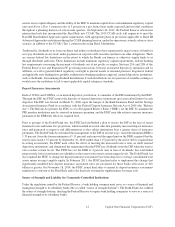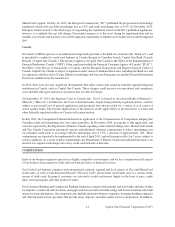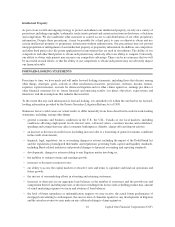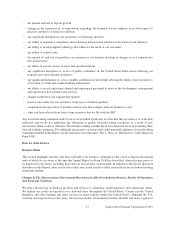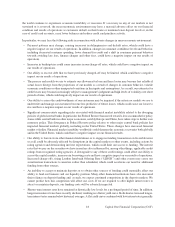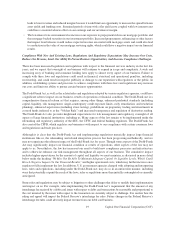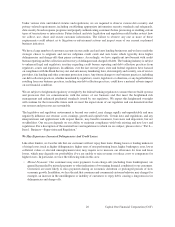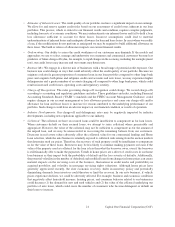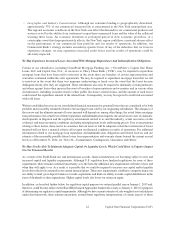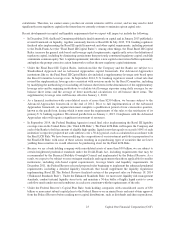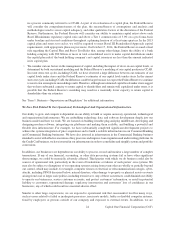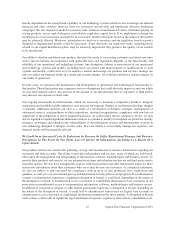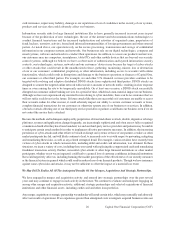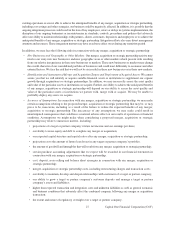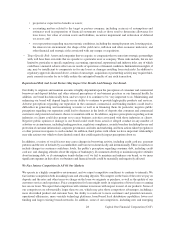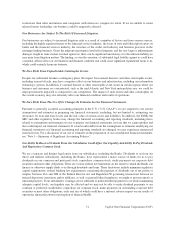Capital One 2014 Annual Report Download - page 44
Download and view the complete annual report
Please find page 44 of the 2014 Capital One annual report below. You can navigate through the pages in the report by either clicking on the pages listed below, or by using the keyword search tool below to find specific information within the annual report.•Geographic and Industry Concentration. Although our consumer lending is geographically diversified,
approximately 37% of our commercial loan portfolio is concentrated in the New York metropolitan area.
The regional economic conditions in the New York area affect the demand for our commercial products and
services as well as the ability of our customers to repay their commercial loans and the value of the collateral
securing these loans. An economic downturn or prolonged period of slow economic growth in, or a
catastrophic event that disproportionately affects, the New York region could have a material adverse effect
on the performance of our commercial loan portfolio and our results of operations. In addition, our
Commercial Bank’s strategy includes an industry-specific focus. If any of the industries that we focus in
experience changes, we may experience increased credit losses and our results of operations could be
adversely impacted.
We May Experience Increased Losses Associated With Mortgage Repurchases And Indemnification Obligations.
Certain of our subsidiaries, including GreenPoint Mortgage Funding, Inc. (“GreenPoint”), Capital One Home
Loans, LLC and Capital One, N.A., as successor to Chevy Chase Bank (“CCB”), may be required to repurchase
mortgage loans that have been sold to investors in the event there are breaches of certain representations and
warranties contained within the sales agreements. We may be required to repurchase mortgage loans that we sell
to investors in the event that there was improper underwriting or fraud or in the event that the loans become
delinquent shortly after they are originated. These subsidiaries also may be required to indemnify certain purchasers
and others against losses they incur in the event of breaches of representations and warranties and in various other
circumstances, including securities fraud or other public disclosure-related claims, and the amount of such losses
could exceed the repurchase amount of the related loans. Consequently, we may be exposed to credit risk associated
with sold loans.
We have established reserves in our consolidated financial statements for potential losses that are considered to be both
probable and reasonably estimable related to the mortgage loans sold by our originating subsidiaries. The adequacy of
the reserve and the ultimate amount of losses incurred will depend on, among other things, the actual future mortgage
loan performance, the actual level of future repurchase and indemnification requests, the actual success rate of claimants,
developments in litigation and the regulatory environment related to us and the industry, actual recoveries on the
collateral, and macroeconomic conditions (including unemployment levels and housing prices). Due to uncertainties
relating to these factors, there can be no assurance that our reserves will be adequate or that the total amount of losses
incurred will not have a material adverse effect upon our financial condition or results of operations. For additional
information related to our mortgage loan repurchase and indemnification obligations and related reserves and our
estimate of the reasonably possible future losses from representation and warranty claims beyond the current accrual
levels as of December 31, 2014, see “Note 20—Commitments, Contingencies, Guarantees and Others.”
We May Not Be Able To Maintain Adequate Capital Or Liquidity Levels, Which Could Have A Negative Impact
On Our Financial Results.
As a result of the Dodd-Frank Act and international accords, financial institutions are becoming subject to new and
increased capital and liquidity requirements. Although U.S. regulators have finalized regulations for some of these
requirements, there remains continued uncertainty as to the form the additional new requirements will take or how and
when they will apply to us. As a result, it is possible that we could be required to increase our capital and/or liquidity
levels above the levels assumed in our current financial plans. These new requirements could have a negative impact on
our ability to lend, grow deposit balances or make acquisitions and limit our ability to make capital distributions in the
form of dividends or share repurchases. Higher capital levels also lower our return on equity.
In addition, as described further below, for regulatory capital purposes we entered parallel run on January 1, 2015 and,
therefore, could become subject to the Basel III Advanced Approaches framework as early as January 1, 2016 for purposes
of determining our regulatory capital requirements. Although we have current estimates of risk-weighted asset calculations
under that framework, there remains uncertainty around future regulatory interpretations of certain aspects of those
22 Capital One Financial Corporation (COF)


